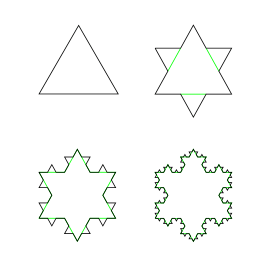Teragon
- Not to be confused with Tarragon.

A teragon is a polygon with an infinite number of sides, the most famous example being the Koch snowflake. Typically, a teragon will be bounded by one or more self-similar fractal curves, which are created by replacing each line segment in an initial figure with multiple connected segments, then replacing each of those segments with the same pattern of segments, then repeating the process an infinite number of times for every line segment in the figure.
Etymology
The word "teragon" comes from Greek τέρας (teras), "monster, marvel", + γωνία (gōnía) "corner, angle" (as in poly-gon). By the standards of classical geometry, a teragon like the Koch snowflake was a marvelous or monstrous object requiring new techniques to understand and analyze.

Other examples
The horned triangle, created by erecting a series of smaller triangles on one corner of an equilateral triangle, is another example of a teragon. It is also an example of a rep-tile, or shape that can be completely dissected into smaller copies of itself.
References
- Mandelbrot, B. B. (1982). The Fractal Geometry of Nature. W.H. Freeman and Company. ISBN 0-7167-1186-9.
